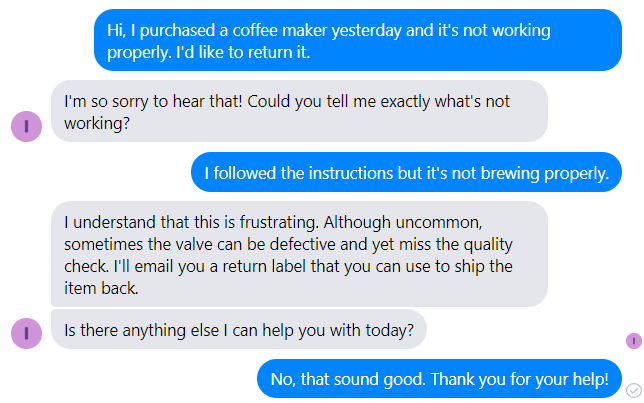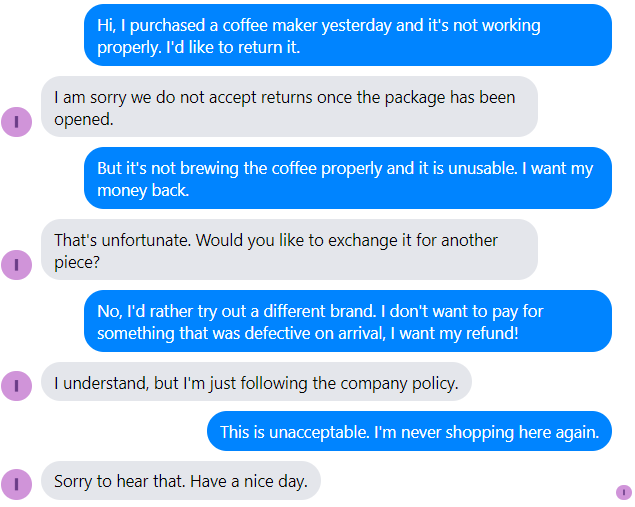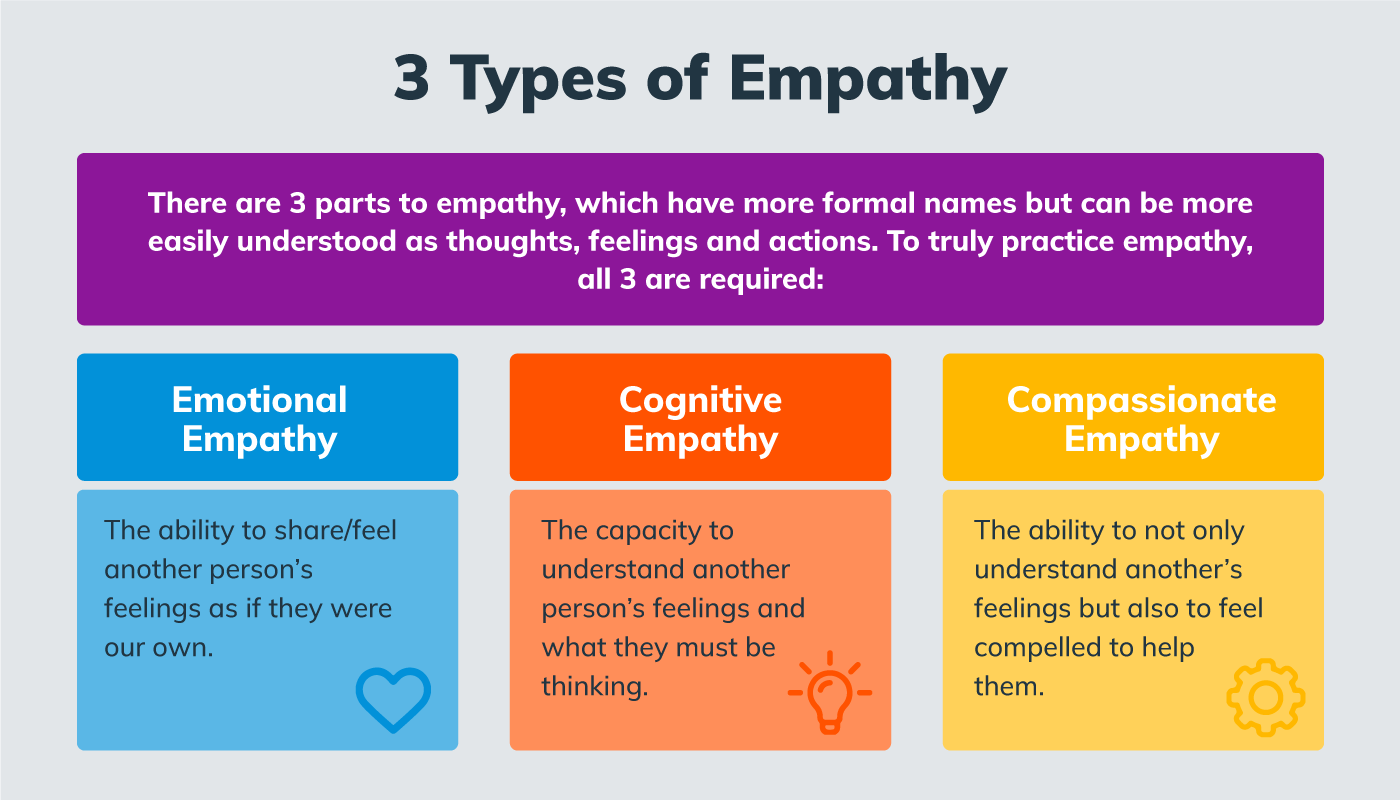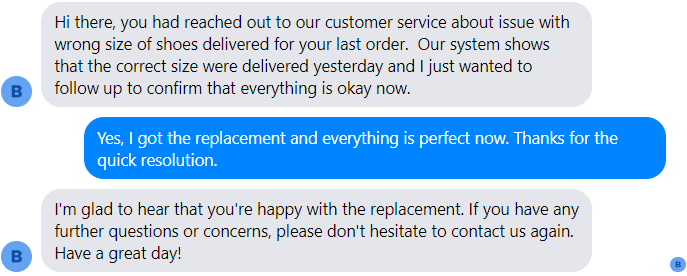
Going above and beyond to provide a memorable brand experience is the difference between providing merely average customer service and providing truly exceptional service.
And at the core of providing a stand-out customer experience is Empathy. Empathy creates a strong bond between the customers and the business, leading to increased customer loyalty and positive word-of-mouth recommendations.
Consider these two scenarios:
Samantha had a scowl on her face. She had purchased a new coffee maker just the day before and was excited to try it out. However, when she got home and tried to use it, she realized it was defective.
She chatted up the company’s customer care representative to lodge a complaint.
In Scenario 1, the exchange went like this:

In this scenario, the customer care representative empathized with her and showed her that he understood the challenge she was facing. His statements helped to diffuse the situation and left Samantha with a positive impression of the store. Samantha would definitely shop more from the store and might even give a word-of-mouth recommendation based on this experience.
In Scenario 2, the exchange went differently:

In the second scenario, the customer care representative did not show empathy. She felt unconcerned about Samantha’s plight which left Samantha feeling frustrated, angry and dissatisfied with the company. She promised never to shop at the company again.
The scenario above affirms this recent report that revealed that 61% of consumers have stopped buying from a company because a competitor provided a better customer experience. Not a better product. Showing empathy can be a key differentiator to attract and retain more customers.
61% of consumers stopped buying from a company because a competitor provided a better customer experience. Not a better product.
In this blog post, we’ll look at 30+ empathy phrases that every customer service representative should use to convey empathy over written communication channels like email or chat.
What is Empathy?
Empathy in customer service refers to the ability of customer service representatives to understand and connect with the emotions, feelings, and perspectives of their customers. It involves putting oneself in the customer’s shoes and acknowledging their concerns, frustrations, and needs in a respectful and compassionate manner.
Empathy can be demonstrated in a variety of ways, such as actively listening to the customer’s concerns, expressing understanding and validation of their emotions, and providing personalized solutions that address their specific needs.
Customer service representatives who demonstrate empathy are often able to build stronger relationships with customers, increase customer satisfaction and loyalty, and improve overall business performance.
According to Maslow’s Theory of Human Motivation, feeling loved and esteemed is one of the basic human needs. When customers feel heard and understood, they trust you and build a connection with your brand.
Considering the fact that 89% of businesses compete based on the quality of their customer service alone, businesses with empathetic customer reps can gain a competitive advantage over others who are not.
89% of businesses compete based on the quality of their customer service alone.
By demonstrating empathy and showing a genuine desire to help, customer service representatives can defuse tense situations, de-escalate conflicts, and find solutions that satisfy both the customer and the company.
Types of Empathy
Here are the three kinds of empathy with examples on how to use them in chat support and better navigate difficult situations.
1. Cognitive Empathy
In customer service, cognitive empathy involves being able to understand and anticipate a customer’s needs, concerns, and expectations. This can involve listening actively to a customer, asking clarifying questions, and using phrases that show you understand their perspective. Cognitive empathy helps to build rapport with the customers, resolve issues more effectively, and improve customer satisfaction.
2. Emotional Empathy
When dealing with customers, emotional empathy involves being able to connect with their emotions and respond appropriately. For example, if a customer is frustrated or upset, a customer service representative with emotional empathy can acknowledge the customer’s feelings and respond with understanding. This can help defuse tense situations, resolve conflicts, and improve customer loyalty.
3. Compassionate Empathy
Compassionate empathy involves not only understanding the emotions and experiences of others, but also taking action to help them. It involves offering support, providing solutions, and doing what is necessary to make the customer feel heard and valued.

Why Empathy is Important in Customer service
Here are a few reasons why empathy is indispensable in customer service.
It Establishes Connection With Customers
Empathy improves the quality of customer service by helping to create good connections between the customer and the service provider. Treating customers with empathy or as a friend will likely make customers feel valued and appreciated, improving their bond with your brand.
It Improves Customer Loyalty and Advocacy
When customers feel that you care about their experience, they are more likely to become loyal to your organization. By building a positive relationship with the customer, you can create a loyal customer who will return to your organization in the future and even become advocates.
Empathy Improves Customer Satisfaction
Empathy can improve customer satisfaction because it demonstrates that you care about the customer’s experience. When customers feel heard and understood, they are more likely to be satisfied with the service they receive.
It Helps to Defuse Tense Situations
Empathy can help you resolve conflicts and tense situations more effectively. When you show empathy, you can better understand the customer’s problem and work towards a solution that meets their needs. This can help to resolve issues more quickly and effectively.
When cases with angry customers are not properly handled, it could negatively affect your brand image. However by showing empathy, you can reduce tension in a difficult situation. When you acknowledge the customer’s concerns and show that you understand their perspective, it can help to calm them down and create a more positive interaction.
Empathy Increases Customer Service Teams Efficiency
By demonstrating empathy and providing personalized support, customer service representatives can develop a sense of purpose and meaning in their work. This fosters a positive work environment which can improve job satisfaction and motivation.
It Improves Bottom Line
Harvard Business Review research suggests the top 10 most empathetic companies increased their monetary value more than twice as much as the bottom 10 companies and generated 50% more earnings. When customer reps show empathy, it increases repeat customers and word of mouth recommendation which would consequently improve the company’s revenue.
Top 10 most empathetic companies increased their monetary value more than twice as much as the bottom 10 companies and generated 50% more earnings.
35 Empathy Phrases every Customer Rep Should Know
These are some essential phrases that every customer service representative should have in their repertoire, as it can make all the difference in how customers perceive your interactions with them.
Acknowledging customer frustration or disappointment
When customers are frustrated, they just want to be heard attentively. Make them feel supported by acknowledging their pain. It opens up communication between you and the customer and gives the customer the opportunity to express their concerns and allows you to gather more information about the issue.
The following phrases can help you acknowledge your customers’ frustration in the best light:
1. I understand how you feel
The phrase “I can understand how you feel” conveys empathy and understanding towards the customer’s situation. When a customer is upset or dissatisfied with a product or service, they want to feel like they are being heard and that their concerns are being taken seriously. Using this phrase shows the customer that you acknowledge their feelings, and that you are on their side.
By empathizing with the customer, you can show that you are not there to argue or dismiss their concerns, but rather to find a solution that will work for them. Keep in mind that these statements should be used within context, authentic and avoid overusing emojis.
2. I’m sorry that happened
Using this phrase shows your commitment to providing great customer service and ensuring that customers feel valued and respected. It demonstrates that you understand the customer’s feelings and that you care about their experience. It also helps create a sense of trust and comfort between customers and customer service reps, which can make resolving the issue at hand much easier.
3. I can understand how this situation affected you
When a customer is upset or angry, saying this can help to de-escalate the situation. When they feel that their emotions are being recognized, they are less likely to become defensive or continue to escalate the situation.
By using this phrase, you are showing empathy towards the customer’s situation. It recognizes their emotions and shows that you are trying to understand their perspective.
4. So sorry you had to go through that
This phrase is an expression of empathy that acknowledges the customer’s negative experience. By using this phrase, you are communicating to the customer that you understand and recognize the difficulty they experienced, and that you care about their experience.
This phrase is particularly useful in situations where the customer has expressed frustration, disappointment, or anger about a problem or issue they experienced with your product or service. It can help to diffuse tension and create a more positive interaction with the customer.
5. I can imagine how difficult this must be for you
When we use this phrase, we are telling the customer that we understand how hard it can be for them to deal with the situation. It shows them how we truly empathize with their experience. This phrase helps customers feel heard, respected, and understood. It also shows that we are willing to put ourselves in their shoes and see why they are feeling the way they are.
For instance, in the event that a customer contacts you regarding a faulty product, you could tell them:
6. I’m sorry this isn’t what you expected
This phrase shows that you take responsibility for the issue and are willing to make things right. It can help the customer feel heard and validated, which can be an important step in resolving the issue.
The phrase also demonstrates empathy and understanding of the customer’s situation. It shows that you are putting yourself in their position and trying to see things from their perspective.
By acknowledging the problem, showing empathy, and apologizing, you are opening the door for a resolution. This can help the customer feel more comfortable communicating with you and can lead to a more productive conversation.
Consider this customer interaction scenario:

Affirming that customers concerns are valid
When customers contact a company with a concern or complaint, they want to feel heard and understood. Validating the customer’s experience helps to build rapport and shows them that you understand the gravity of their situation.
7. I would feel the same way in your situation
This phrase is a powerful tool in customer service because it shows empathy towards the customer and demonstrates that you understand their emotions and perspective. It is a way of validating the customer’s feelings and letting them know that they are not alone in their experience.
The phrase can be used in a variety of situations in customer service, such as when a customer is expressing frustration, disappointment, or anger about a product or service.
8. What you said totally makes sense
The phrase can be used in a variety of situations in customer service, such as when a customer is providing feedback or making a suggestion for improvement.
For example, if a customer suggests a new feature for your product, you might say
However, it’s important to remember that this phrase should not be used as a way to dismiss or ignore the customer’s concerns. Instead, it should be used as a way to demonstrate that you are committed to finding a solution that meets their needs.
9. Your concerns are completely understandable
The phrase can be used in a variety of situations in customer service, such as when a customer is expressing confusion, frustration, or anger about a product or service.
An example of when this phrase can be useful in customer service is when a customer is experiencing a problem that is affecting their ability to use your product or service.
Here’s a case in point:

10. I was able to reproduce the issue — it’s not just you
This phrase is important in customer service because it helps to validate the customer’s experience and can reduce frustration or confusion. When a customer reports an issue or problem with a product or service, they may feel like they are the only one experiencing it, or that they are doing something wrong. By acknowledging that the issue exists and that it is not isolated to the customer, the customer feels understood and reassured.
This phrase should be used when a customer reports an issue that you are able to replicate or experience for yourself. It’s important to be honest with the customer about the issue, and to let them know that you are working to resolve it.
11. Yes, I can see the problem from my end!
This phrase should be used when a customer reports an issue that you are able to identify or confirm from your end. It’s important to reassure the customer that you have seen the issue and are actively working to resolve it. Additionally, by confirming that you can see the issue from your end, you can help the customer understand that you have the necessary information and tools to resolve the problem.
12. I get how this could be confusing
This phrase should be used when a customer is expressing confusion or difficulty understanding a particular aspect of a product or service. It’s important to recognize that the customer may be feeling frustrated or overwhelmed, and that acknowledging their confusion can help to defuse the situation.
Using this phrase can help to establish rapport with the customer and build trust. It shows that you are willing to listen to their concerns and that you understand their perspective. This can lead to a more positive customer experience and increased customer loyalty.
Showing understanding and support
Customers want to feel that their concerns are being taken seriously and that the company cares about their experience. Showing understanding and support can help improve customer satisfaction and create positive experiences.
Here are some phrases to express understanding and support:
13. I’m here to help
Using this phrase when interacting with customers can create a positive experience, making them feel heard and valued. It also sets the tone for the conversation and shows that you are ready to take ownership of the problem.
This phrase can be used in various situations such as when a customer is experiencing an issue, when they are seeking clarification or assistance, or when they need guidance on a particular product or service.
14. What can I do to make things better
This phrase is essential in customer service because it demonstrates a willingness to go above and beyond to address a customer’s concerns or complaints. It conveys empathy, concern, and a sincere desire to improve the customer’s experience.
This phrase is particularly useful when a customer is dissatisfied with a product or service and expresses their frustration or disappointment. By asking this question, you are inviting the customer to provide input and collaborate on finding a solution. This can help to de-escalate a tense situation and create a more positive outcome.
15. I’ll do my best to resolve this for you
Using this phrase helps to convey a sense of empathy and understanding towards the customer’s issue. It also sets the expectation that the representative will put forth their best effort to resolve the problem, which can help build trust and confidence in the company’s commitment to customer satisfaction.
This phrase is particularly useful when a customer is experiencing a problem that may not have an immediate or straightforward solution. By stating that they will do their best, the representative is effectively communicating that they are committed to helping the customer, even if it may take some time or effort to find the right solution.
Consider this scenario:

16. I’ll be with you every step of the way
Using this phrase is essential in situations where the customer may feel overwhelmed or uncertain about the process of resolving their issue. By stating that the representative will be with them every step of the way, it helps to build trust and confidence in the customer that they will receive the necessary support and guidance to find a resolution.
This phrase is particularly useful when a customer is experiencing a complex issue that requires multiple steps or interactions to resolve. By assuring the customer that the representative will be there to assist them throughout the process, it can help to alleviate any anxiety or frustration they may be feeling and provide a sense of comfort and reassurance.
17. I’m dedicated to finding a resolution for you
This phrase is particularly useful when a customer is experiencing a persistent or recurring issue that has not been resolved in the past. By assuring the customer that the representative is dedicated to finding a resolution, it can help to alleviate any frustration or disappointment they may be feeling and provide a sense of reassurance that their issue will be addressed.
It is important to note that using this phrase should be done sincerely and only when the representative is truly committed to finding a resolution for the customer. Overusing the phrase or using it insincerely can lead to a lack of trust and credibility with customers.
18. Please tell me more about what exactly you are facing
The phrase “Please tell me more about what exactly you are facing” is crucial in customer service as it demonstrates active listening and empathy towards the customer’s problem. Using this phrase shows that you are genuinely interested in understanding the customer’s issue and willing to work towards finding a solution.
It is important to use this phrase when a customer presents a problem or complaint that requires further explanation or details. By asking the customer to elaborate on their issue, you can gather more information to better understand the situation and offer an appropriate solution.
Offering a Solution
When a customer contacts customer service, they are often looking for a resolution to a problem or seeking assistance in some way. Offering a solution is a great way to show the customer that you are there to help and eager to provide them with a satisfactory outcome.
Here are some phrases to use when offering solutions:
19. Don’t worry, there’s a quick way to fix this
This is an important phrase in customer service as it helps to reassure the customer that their problem can be resolved quickly and efficiently. It is a phrase that can help alleviate any anxiety or frustration the customer may be experiencing and provide them with a sense of relief that their issue will be resolved.
20. Here’s how you can get it working again
This phrase is particularly useful in situations where the customer is experiencing a technical issue or is having trouble using a product or service. By providing the customer with step-by-step instructions on how to resolve the issue, the customer service representative can help the customer to feel more confident and in control of their situation.
Using this phrase can also help to reduce frustration and anxiety for the customer. By providing a clear solution, the customer service representative can help the customer to feel less overwhelmed and more empowered to resolve their issue.
21. I’ll work with our team here to resolve this
This phrase is typically used in situations where the representative does not have the authority or resources to resolve the issue on their own. For example, if a customer has a technical issue that requires the expertise of a specialized team member, the representative can use this phrase to communicate that they will work with their team to find a resolution.
When using this phrase, the representative should communicate any relevant information about the timeline or steps involved in finding a solution.
22. I’m working on this right away and will share an update shortly
Using this phrase is appropriate when a customer has raised a specific issue or request that requires action on the part of the customer service representative. By stating that they are working on the issue right away, the representative is showing the customer that they take their concerns seriously and are committed to resolving the issue as soon as possible.
Additionally, the representative is setting clear expectations for the customer and demonstrating that they value communication and transparency. This can help to build trust and confidence in the customer service experience.
Here’s a case in point:

23. I’ll get back to you as soon as possible
This phrase communicates to the customer that the representative has heard their concern and is committed to finding a solution, even if they are not able to provide an immediate resolution. This phrase also conveys a sense of urgency and a desire to keep the customer informed about the progress being made.
This phrase is typically used when the representative does not have an immediate solution to the customer’s issue or requires additional time to investigate the matter. For example, if a customer has a question that requires research or consultation with a supervisor, the representative can use this phrase to communicate that they will follow up with the customer once they have more information.
Handling Angry Customers
Handling angry customers is a challenging aspect of customer service because it can have a significant impact on the customer’s experience and the reputation of the company. Whatever you say can make or break the situation. Let them know they have every right to be mad at you and share a sincere apology.
Here are some phrases to handle angry customers:
24. You’re totally right. I will act on this immediately
When a customer is unhappy with a product or service, it is important for customer service representatives to acknowledge the customer’s frustration and validate their concerns. This phrase accomplishes that by affirming the customer’s viewpoint and indicating that the representative is taking responsibility for resolving the issue.
Using this phrase at the appropriate time in the conversation can help deescalate the situation and build trust with the customer. It can also help to set expectations for the customer, indicating that the issue will be addressed promptly and that they will be kept informed of any progress.
Here’s a case in point:

25. If I were in your place, I would feel the same way
When a customer contacts customer service with a problem or complaint, they often feel frustrated or upset about the situation. Acknowledging the customer’s worries demonstrates that the representative understands how they are feeling.
Using this phrase at the appropriate time in the conversation will build rapport with the customer and create a positive atmosphere for finding a solution to the problem. It shows that the representative is actively listening to the customer and cares about their concerns, which can help to ease any negative emotions the customer may be feeling.
26. I’m sorry you’re disappointed with your experience
When a customer expresses dissatisfaction with a product or service, it is important for customer service representatives to validate the customer’s emotions and show that they understand how the customer feels. This phrase accomplishes that by expressing regret for the customer’s disappointment and empathizing with their situation.
Using this phrase at the appropriate time in the conversation can help to deescalate the situation and build rapport with the customer. It shows that the representative is actively listening and cares about the customer’s experience, which can help to diffuse any negative emotions the customer may be feeling.
27. I’m extremely sorry. I will make sure this doesn’t happen again
It is important to use this phrase when a customer experiences a significant problem or recurring issue with a product or service. By taking accountability for the issue and promising to prevent it from happening again, the representative can demonstrate that they are committed to the customer’s satisfaction and willing to take steps to ensure that the issue is resolved permanently.
Confirm Client’s Satisfaction
When ending a conversation with a client, it’s important to confirm that the client’s needs have been met and encourage them to contact you again should they have any further concerns.
28. Feel free to reach out if you have any other questions or concerns
Using this phrase at the end of the conversation can help to leave a positive impression with the customer and create a sense of ongoing support. It shows that the representative is committed to the customer’s satisfaction and is willing to help them with any future questions or concerns they may have.
29. I’m just following up to confirm that the problem has been resolved
After a customer has raised a concern or problem, it’s important for the representative to follow up and confirm that the issue has been resolved to the customer’s satisfaction. Using this phrase can help to show the customer that the representative is taking their concerns seriously and is committed to ensuring that their problem has been fully resolved.

Showing Gratitude
It is important to show appreciation to customers who reach out to us with their concerns. Expressing gratitude for their efforts in bringing an issue to our attention is a great way to demonstrate empathy and respect. Customers who feel appreciated and valued are more likely to remain loyal to your business.
These are examples of phrases to show appreciation, convey professionalism and strengthen the customer-company relationship in customer care,:
30. Thank you for bringing this to our attention
Expressing gratitude for customers’ efforts in bringing an issue to our attention will make customers feel that their feedback is appreciated and taken seriously. Not only does it help them calm down about the situation, but it also encourages them to communicate openly and honestly about their experiences.
31. Thank you for taking the time to reach out
Acknowledging that your customer’s time is valuable and that you appreciate them contacting you will make them feel respected and valued.
You can use this phrase in many different ways. You can use it at the start of your conversation when you first greet the customer. This will set the tone for the rest of the conversation. You can also use it after you have provided them with the assistance they requested. This shows that you recognize the effort they put into contacting you and that you’re thankful for their patience.
32. Thank you for giving us an opportunity to do better
When a customer provides feedback or expresses dissatisfaction, it presents an opportunity for the company to make improvements and provide better service in the future. By thanking the customer for bringing the issue to their attention and presenting it as an opportunity to improve, the company shows that they are taking the feedback seriously and are committed to making things right.
Using this phrase also helps to defuse potentially tense situations, as it shows empathy and a willingness to address the customer’s concerns. It can help to prevent the customer from feeling dismissed or ignored, which can often exacerbate a negative experience.
Here’s a case in point:
33. We really appreciate your honest feedback!
By acknowledging the customer’s feedback and demonstrating appreciation, the representative can help to establish a connection with the customer and create a more positive conversation that focuses on finding a solution to the problem.
34. Thanks for your patience
This phrase is an important tool in customer care as it helps to convey appreciation and gratitude towards the customer for their willingness to wait or work through a problem.
Using this phrase at the appropriate time in the conversation can help to build rapport with the customer and create a positive atmosphere for finding a solution to the problem. It shows that the representative is aware of the customer’s efforts and is grateful for their willingness to work through the problem.

35. Thank you so much for notifying us about the issue
When a customer takes the time and effort to report a problem or issue with a product or service, it indicates that they have trust in the company to address their concerns.
By thanking the customer for notifying the company, the company shows that they value the customer’s feedback and are committed to providing excellent customer service.
Moreover, the phrase “notifying us about the issue” acknowledges that the company understands the importance of prompt and proactive communication with customers. It also sets a positive tone for the interaction and helps to build trust and rapport with the customer, which is crucial for maintaining long-term customer relationships.
Conclusion
Empathy is not only a fundamental principle of good customer care but also a valuable investment in any business. By understanding and acknowledging your customers’ emotions, you can provide a better experience and avoid potential negative outcomes. Remember, a little empathy can go a long way in creating a positive and long lasting relationship with your customers.
In some cases, there may have been no resolution at all, but if you show your consumers you understand how they feel, it will go a long way toward making them feel appreciated and giving you another chance to earn their business.